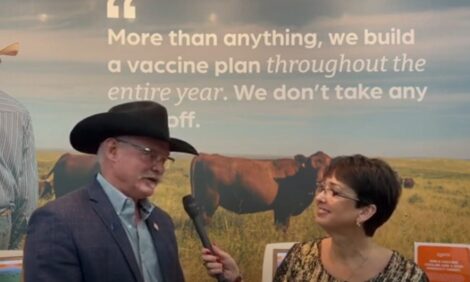



Parasites Interfere With Productivity And Profitability
By Merial.Parasites interfere with productivity and profitability
Calves are at risk
Worms in the gut usually have their worst effects on productivity in calves. The problem starts when a calf swallows worm larvae while grazing. These larvae either develop in the wall of the true stomach (abomasum) in the case of the most important internal parasite, the brown stomach worm Ostertagia ostertagi, or become resident in the small intestine. Cooperia species are the most common intestinal worm, although Trichostrongylus and Nematodirus are important in some geographic areas. The larvae then mature to become adult worms. Adult female worms lay eggs in the gut, usually starting about 3 weeks after larvae were swallowed. The eggs are then passed in the dung where, under the right temperature conditions, they hatch if sufficient moisture is present. The larvae that emerge from the eggs migrate from the dung pat onto the pasture.
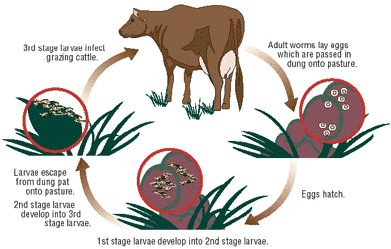
Older cattle are at risk
As a calf grows, it develops some immunity to parasite infection. This immunity is not total, and worms still occur in the gut if an older calf (or yearling or adult) is grazing. Young calves will have more worms than yearlings, and yearlings will have more worms than adult cattle, but they all will have some internal parasites. Immunity reduces the size of the worm burden, and it also reduces the number of eggs those worms produce. That is why in older cattle, fecal egg counts are not reliable as an indicator of parasite infection. Egg counts provide a better indication of infection in calves than in older cattle.
Even if infection is not obvious, worms in the gut can still significantly reduce cattle productivity, causing:
- Weight loss
- Water loss
- Protein loss
- Mineral loss
- Nitrogen loss
- Blood loss
- Appetite suppression
- Impairment of feed conversion
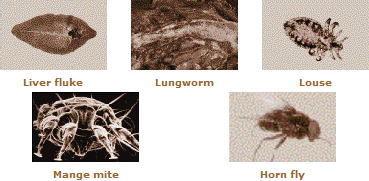
In addition to gut worms, other parasites cause productivity problems in cattle of all ages. IVOMEC is the only brand to offer formulations that provide broad spectrum control and long lasting action, not just against gut worms but also against many other profit-robbing parasites that can lower cattle productivity:
- Liver fluke (Fasciola hepatica): reduce weight gain, feed efficiency, milk production, and conception rates; cause liver condemnation.
- Lungworms (Dictyocaulus viviparus): cause respiratory disease, death, worsen bacterial and viral respiratory disease.
- Lice (biting lice and sucking lice): cause irritation, blood loss, and loss of productivity.
- Mange mites (chorioptic mange, sarcoptic mange, psoroptic mange): cause irritation and loss of productivity.
- Horn flies (Haematobia irritans ): cause irritation, interfere with grazing, and cause loss of productivity.
Early antiparasitic products
Because of their economic importance, parasites have long been the subject of scientific research. For internal parasites, an evolution in new products has occurred. In the early 1960s, the first of the benzimidazoles (BZs), thiabendazole (TBZ), heralded a breakthrough in the efficacy and safety of antiparasitic drugs. Levamisole soon followed — a compound with a mode of action different from the BZs.
Even though levamisole had a relatively low safety margin, it was a valuable drug for controlling lungworm and other parasites and was the first broad-spectrum pour-on to control internal parasites. Levamisole was followed by new BZs, including fenbendazole, albendazole, and oxfendazole. These were more effective than TBZ and levamisole, especially against larval parasite stages in the lungs and gut. However, while these products were effective against internal parasites, additional products, such as organophosphates (OPs) or pyrethroids, were still needed to control lice, mange, and flies.
Despite the shortcomings of the early products, their use led to productivity improvements in all ages of cattle, particularly in calves. However, these drugs were not reliably effective against the larval stages of O. ostertagi, especially the inhibited (dormant) larvae in the stomach wall. Further, the BZs were not user-friendly because they were only available as oral treatments. Levamisole also was ineffective against many larvae and there was concern about the safety margin. It was obvious that a breakthrough was needed — a breakthrough that would improve the efficacy, convenience, and safety of antiparasitic treatments, and substantially improve the profitability of livestock production.
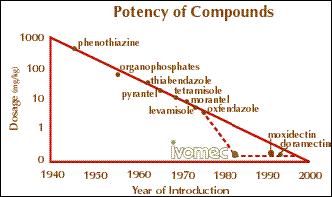
The importance of the IVOMEC breakthrough is shown in the graph above which charts the reduction in dose (amount of active ingredient) of anti–parasitic compounds over the past 50 years. Note that the IVOMEC dose, 200 mcg/kg achieved in 1981, was not duplicated by competing products in Europe until 1994 — 13 years later. The leap ahead that IVOMEC made remains unequalled — no compound has been found that improves on the low dose of IVOMEC.
The greatest breakthrough: IVOMEC
A new way of seeking out active antiparasitic compounds, by screening samples of soil taken from around the world, yielded success in 1975. Scientists in charge of the program found a soil-dwelling organism, Streptomyces avermitilis, which produced highly active antiparasitic compounds. The discovery triggered years of intense scientific activity that resulted in the introduction of IVOMEC, the first endectocide of the avermectin/milbemycin class. Compared to other antiparasitic drugs, IVOMEC offered a breakthrough in efficacy, safety, and convenience at a dose that was a fraction of that of earlier compounds.
Despite the presence of other endectocides, IVOMEC continues to be the most widely used and trusted brand in the history of animal health. However, it is not just in animal health that ivermectin has revolutionized parasite control. More than 50 million doses have been given to people, reflecting its excellent safety profile.
Ivermectin, the active ingredient of the unique formulations that make up the family of IVOMEC products, is now registered for use in 13 mammalian species and in 90 countries. More than 3000 scientific publications show ivermectin’s efficacy against 190 internal and 120 external parasites. More than 5 billion doses have been distributed worldwide, including more than 2 billion doses for cattle. Keys to the achievements of IVOMEC have been its high, long-lasting efficacy against a broad spectrum of parasites, its safety profile, and its unequalled convenience. IVOMEC is available in a range of patented user-friendly formulations designed to optimise efficacy and improve the ease of parasite control.
IVOMEC, research and productivity
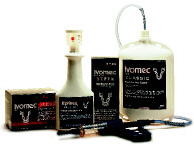
Since the launch of IVOMEC, work has progressed to show how each formulation may be used to improve the profitability of cattle production. Global trials focusing on first and second season calves, suckler cow herds, beef and dairy operations have proved that parasite control with IVOMEC can result in increased body weight gain, faster growth to critical minimum heifer breeding weight, shorter calving-to-conception intervals, improved productivity in calves reared by treated cows, and improved milk production in dairy cows.
Our research also continues to bring revolutionary new products to market, including EPRINEX Pour-On for Beef and Dairy Cattle, the only parasite control product to have a zero milk withdrawal in every country in which it is available. EPRINEX Pour-On is the most powerful product ever produced for controlling internal parasites and has the same broad-spectrum activity as ivermectin against external parasites. The launch of EPRINEX signals that productivity benefits of endectocide treatment are now available for dairy cattle, regardless of stage of lactation.
Unique production benefits of parasite control with IVOMEC
Field trials using IVOMEC have been conducted in many different countries under a range of management conditions. The results show that, for first season and suckling calves which are most at risk of parasite disease, IVOMEC provided a major step forward in production enhancement. Trials also showed that even where there was a low parasite challenge, in conditions where egg counts were very low even in calves, productivity enhancement from parasite control with IVOMEC increased profitability.
In heifers, whether dairy or beef, using IVOMEC to control parasites led to earlier attainment of critical minimum weight for mating, making it possible for overall herd fertility improvements to occur. This led to more research on the benefits of treating adult animals. Cows treated with IVOMEC in late pregnancy weaned significantly heavier calves. And the benefits of IVOMEC appear to be related not only to improved milk production and better calf performance, but also to significant improvement in cow reproductive performance.
Many of the trials that show these benefits, from the United Kingdom, Europe, and around the world, are listed below — continuing proof that IVOMEC remains the gold standard in parasite control, unsurpassed in efficacy and unequaled in convenience. See for yourself the production benefits that IVOMEC brings.
Studies
- Housed cattle United Kingdom
- Housed calves Germany
- Feedlot cattle United States
- Grazing calves United Kingdom
- Grazing calves Belgium
- Grazing calves United States
- Grazing calves New Zealand
- Grazing calves Brazil
- Grazing calves Ireland
- Grazing calves Europe
- Grazing calves United States
- Beef heifers United States
- Beef heifers New Zealand
- Suckler herds United States
- Suckler herds Canada
- Dairy heifers United Kingdom
- Dairy heifers Belgium
- Dairy heifers North America
- Dairy cows The Netherlands
- Dairy cows Australia

